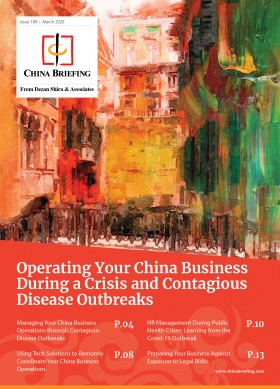Hong Kong Budget 2020-2021: Rebooting the Economy
2019 was a year fraught with challenges for all people in Hong Kong. Reeling from the uncertainties of the US-China trade conflict, unprecedented levels of social unrest, and the unexpected outbreak of COVID-19 – the year has tested Hong Kong’s resilience on all fronts. The economy, in turn, suffered a significant downturn – contracting 1.2 percent – with the consumption and tourism sectors being some of the hardest hit.
Responding to this, Financial Secretary Paul Chan, in February, unveiled what many observers hail as the most ambitious and far-reaching Hong Kong budget to date.
Under the theme of “supporting enterprises, safeguarding jobs, stimulating the economy, and relieving people’s burdens,” the budget contains a raft of one-off rebates and waivers to relieve against external pressures felt by both individuals and businesses – the focus on rebooting the economy.
The government this year increased its national expenditure by approximately 20 percent, forecasting a budget deficit of HKD 139.1 billion (US$17.9 billion) (about 4.8 percent of Hong Kong’s GDP) in 2021.
Here, we take a look at the highlights of the 2020-2021 budget that will take effect at the start of Hong Kong’s fiscal year in April.
Relieving individual burdens
Of the HKD 139.1 billion (US$17.9 billion) allocated for the 2020-2021 budget, HKD120 billion (US$15.5 billion) has been designated for what is known as ‘relief measures’ for individuals.
Most notably, this includes HKD 10,000 (US$1,289) cash out to all Hong Kong permanent residents aged 18 years or above – this is expected to reach over 7 million people, amounting to around HKD 71.1 billion (US$9.2 billion). “These handouts will boost the city’s economy by around 1 percent,” Financial Secretary Paul Chan told media sources after the delivery of the Budget.
In addition to this, an extra month of welfare payments will be provided to recipients of CSSA payment, Old Age Allowance, Old Age Living Allowance or Disability Allowance, or some Work Incentive Transport Subsidies.
Rates for residential properties for 2020-21 will also be waived up to a ceiling of HKD 1,500 (US$193) per quarter, while lower income tenants living in public rental units will receive one month’s rent free.
Similar to last year, the examination fee for candidates sitting the HKDSE Examination in 2021 will be covered by the government under the budget.
Salaries tax, which are already considered to be one of the lowest personal taxes in the world ranging between 2-17 percent, will be reduced by 100 percent in the 2019-2020 assessment year, subject to a ceiling of HKD 20,000 (US$2,579).
However, there will be no changes to tax rates or bandings, with the last adjustment occurring in the 2018-19 tax year.
Jennifer Lu, Senior Manager at Dezan Shira & Associates’ Corporate Accounting Services in Hong Kong observes that, “Given the changes made in 2018-19, it is not surprising to me that the general salaries tax policy will remain at the similar level for the next few years.”
Lu, however, notes that ‘‘In my point of view, it would have been good to see a tax incentive plan for businesses to attract more high-skilled talents in key industries, such as research, innovation, and technology development – as these talents will largely help these industries to grow and develop faster.”
Supporting business and safeguarding jobs
The relief package also includes various concessions for businesses – such as fee waivers, tax reductions, rent and utility fee cuts, and funding for additional employee training.
The budget will retrospectively reduce profit tax by 100 percent for the assessment year 2019-2020, subject to a ceiling of HKD 20,000 (US$2,579). This is estimated to reach over 141,000 taxpayers and will cut government revenue by HKD 2 billion (US$257.8 million). Again, no changes were made to the tax rate or bandings.
Lu comments, “The two-tiered tax rates for profits tax meant that the business’ first HKD 2 million (US$257,840) of assessable profits will be subject to a lower tax rate of 8.25 percent and only assessable profits exceeding this will be taxed at a higher rate of 16.5 percent. Many SMEs have been able to benefit from this tax scheme since it became effective in April 2018,. However, there is more that could have been done to attract more high-level foreign direct investments in especially the IT industry. Hong Kong is lagging behind on this fast-developing industry and a tax incentive plan to support investments into this industry will encourage more local IT companies as well as international investors to set up businesses in the city.”
In addition, 1.5 million business operators will benefit from the waiver of business registration fees for the year 2020-21. Company registry fees for annual returns will be waived for two years to benefit 1.4 million firms at a cost of HKD 212 million (US$27.3 million).
A concessionary low-interest loan of up to HKD 2 million (US$257,840) will be provided to enterprises under the SME Financing Guarantee Scheme, with a maximum loan of HKD 2 million (US$257,840) with repayment period up to 3 years.
Other measures for businesses include:
- Reducing rates for non-domestic properties for 2020-21 up to a ceiling of HKD 5,000 (US$644) per quarter in the first two quarters and a ceiling of HKD 1,500 (US$193) per quarter in the remaining two quarters for each non-domestic property;
- A 75 percent discount up to a ceiling of HKD 5,000 (US$644) for four months for non-domestic electricity accounts, and 75 percent water and sewage discount on costs up to a cap of HKD 20,000 (US$2579) and HKD 12,500 (US$1,611) respectively; and
- Reduction of fees and rent for cruise lines and cruise terminal tenants for up to 6 months.
The Financial Secretary also outlined various measures that would support employees.
An additional HKD 30 million (US$3.9 million) of annual funding will be provided to the Labour Department to develop more employment programs, this is expected to benefit 4,000 people annually.
Initiatives already existing under the program include:
- The Employment Program for Elderly and Middle-Aged;
- The Youth Employment and Training Program; and
- The Work Orientation and Placement Scheme
HKD 200 million (US$25.8 million) has been allocated to the Construction Industry Council for training allowances for workers, and to subsidize SME contractors and registered and subcontractors with a ceiling of HKD 20,000 (US$2,579).
And the Employees Retraining Board Initiatives will enhance their Love Upgrading Special Scheme in July 2020 to provide 10,000 additional places and increase maximum monthly allowance of eligible trainees from HKD 4,000 (US$516) to HKD 5,800 (US$748). This scheme is designed to help those unemployed, or in a period of extended no pay leave, to upgrade their skills for self-enhancement, with a view to re-entering the employment market.
The government will provide a one-off special allowance to around 200,000 eligible low-income householders under the anti-epidemic fund.
Stimulating the economy
The Hong Kong government has also reiterated its support for sectors hardest hit by the economic downturn including retail, tourism, and trade, while bolstering its support for emerging industries, such as the technology and creative industries.
For the retail industry, the government has pledged HKD 13 billion (US$1.7 billion) in inflation-linked retail and silver bonds. A further HKD 66 billion (US$8.5 billion) has been allocated for issuing green bonds over the next 5 years.
Alongside this, an additional HKD 700 million (US$90.2 million) has been allocated for the Hong Kong Tourism Board to bolster external promotion. This is after tourism dropped an average of 46 percent in the period of September to December 2019 when compared to the previous year, due largely to the effects of the protests and COVID-19 outbreak.
In respect to trade, HKD 150 million (US$19.3 million) has been set aside for Hong Kong Trade Development Council to assist Hong Kong enterprises in exploring new business opportunities.
An additional HKD 900 million (US$116 million) has been earmarked for the Arts Development Matching Grants Scheme, which is intended to diversify its industries from support China’s diversification of its economy.
The innovation and technology sector also received a slew of different measures and grants to support ongoing projects initiatives particularly in smart city development and research and development for new technology and innovation. In 2020-2021 including:
- HKD 345 million (US$44.5 million) for the pilot subsidy scheme to encourage the logistics industry to enhance productivity through the application of technology;
- HKD 3 billion (US$390,000 million) for Phase 2 of the Science Park Expansion Program; and,
- HKD 40 million (US$5.2 million)to subside short-term internships for undergraduates and postgraduates taking Science Technology Engineering and Math Programs in local universities.
Hong Kong’s future outlook for 2020-2021
Supported by a robust and healthy fiscal reserve, Hong Kong’s has demonstrated that it is well positioned to weather the internal and external economic headwinds
Already, in the week leading up to the budget proposal, Carrie Lam introduced measures worth HKD 30 billion (US$3.9 billion) to help small and medium sized companies and low-income households cope with the COVID-19 outbreak.
The 2020-20221 budget subsequently injected a record amount of HKD 120.9 billion (US$15.6 billion) into its economic expenditure – a figure that quadrupled from the budget in the previous year.
Rebounding from a tough 2019, China’s GDP growth is expected to rebound to 1.7 percent GDP growth in 2020.
“The 2020/21 Budgets is overall consistent with previous years’ proposals without many surprises,” however, Lu comments, “some people and businesses were expecting a more aggressive and effective proposal to support them in such difficult time.”
Challenges remain for Hong Kong in the short to medium term – particularly in respect to how it responds to the coronavirus pandemic and continued social unrest.
Still, Hong Kong, continues to pose many key benefits for foreign investors, such as its strategic positioning as the entryway into Mainland China’s market, and new opportunities offered by both the Greater Bay Area Plan and Belt and Road Initiatives.
About Us
China Briefing is written and produced by Dezan Shira & Associates. The practice assists foreign investors into China and has done since 1992 through offices in Beijing, Tianjin, Dalian, Qingdao, Shanghai, Hangzhou, Ningbo, Suzhou, Guangzhou, Dongguan, Zhongshan, Shenzhen, and Hong Kong. Please contact the firm for assistance in China at china@dezshira.com.
We also maintain offices assisting foreign investors in Vietnam, Indonesia, Singapore, The Philippines, Malaysia, and Thailand in addition to our practices in India and Russia and our trade research facilities along the Belt & Road Initiative.
- Previous Article New Export Tax Rebates, Customs Duty Exemptions for China-Based Trading Companies
- Next Article Post COVID-19, China Rebound Could Assist Brazilian Exports








